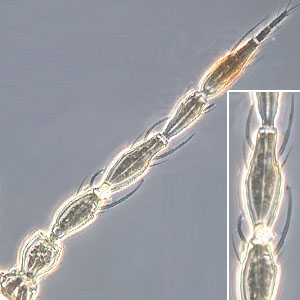Figures
Fig. 1: Antenna (inset: III. and IV. antennal segment)
Fig. 2: Head dorsal with ocellar triangle
Fig. 3: Pronotum
Fig. 4: Meso- and metanotum
Fig. 5: Fore- and hindwing
Fig. 6: Tergites VIII and IX
Fig. 7: Tergite VIII
Taxonomic Information
Species:
Danothrips trifasciatus Sakimura, 1975
Common name:
None established
Present taxonomic position:
Family: Thripidae Stephens, 1829
Subfamily: Thripinae (Stephens) Karny, 1921
Genus: Danothrips Bhatti, 1971
Species Recognition
General information about the genus Danothrips:This genus was described by J.S. Bhatti in 1971 and in 1980 he described the character differences between this genus and the Chaetanaphothrips genus.
Typical character states of Danothrips trifasciatus:
Body color
Mainly pale or yellow, with some darker markings
Antennae
Number of antennal segments: 8
Segment IV - forked sensorium: extending to a point at least 30% distal to base of segment V
Segments II and III shape: more or less symmetric
Segments III & IV sensoria: emergent and forked
Base of sensorium on antennal segment VI: no more than 2 times as wide as base of nearest seta
Terminal antennal segments: rarely elongate
Head:
Distance between bases of ocellar setae III: greater than width of first ocellus
Head shape between compound eyes: not prolonged
Ocellar setae III on head: arising on anterior margin of, or in front of, ocellar triangle
Postocular setae I: absent
Surface of head, pronotum and fore legs: without strong reticulate sculpture
Ocellar setae I in front of anterior ocellus: absent
Prothorax
Number of pairs of elongate pronotal setae: 0-3
Number of pairs of elongate posteroangular pronotal setae: 1-2
Pronotum shape: rectangular
Mesothorax
Mesothoracic endofurca: without median spinula
Metathorax
Metanotal median area sculptured lines: with transverse reticulation
Metanotal median setae length: shorter than lateral metanotal setae
Metanotal median setae position: arising behind anterior margin
Metanotum: without campaniform sensilla
Metanotum major sclerite: with two major sclerites, metascutum and metascutellum
Metanotum median area: with no equiangular reticulation
Metanotum sculpture: without dominant sculptured triangle medially
Metathoracic endofurca: transverse, sometimes with simple median spinula
Wings
Wings: present and more than half as long as abdomen
First vein of forewing: distinct from costal vein
Forewing anterior margin: with setae and cilia but cilia longer than setae
Forewing color: alternating bands of dark and light
Forewing costal fringe of cilia: arising at anterior margin of wing
Forewing costal setae at middle of wing: shorter than median width of wing
Forewing first vein setal row: incomplete, with setae not closely and uniformly spaced
Forewing posterior margin cilia: undulated near apex
Forewing second vein setal row: incomplete, with setae not closely and uniformly spaced
Forewing surface: not reticulate
Forewings: with veins, setae and microtrichia
Legs
Fore tibial apex: not extending around fore tarsus - with small curved claw ventrolaterally
Mid and hind tarsi: with two segments
Abdomen:
Abdominal pleurotergites: not covered in microtrichia
Abdominal segment X: never tubular, longitudinally incomplete ventrally in both sexes
Abdominal sternite II: with marginal setae but no discal setae
Abdominal sternite III of female: without glandular areas
Abdominal sternite VII median marginal setae: arising at margin
Abdominal sternites IV , V and VI: with marginal setae but no discal setae
Number of lateral marginal setae on abdominal tergite II: 3
Abdominal tergites: without curved wing-retaining setae
Abdominal tergites IV & V median setal pair: much shorter than distance between their bases
Abdominal tergites V-VII: without paired ctenidia, sometimes with irregular microtrichia
Setae on abdominal tergite X: slender
Surface of lateral thirds of abdominal tergites: without regular rows of fine microtrichia
Ctenidia on tergite VIII: not present, but groups of microtrichia
Tergite VIII posteromarginal comb of microtrichia: absent
Biology
Life history:
Larvae are described in Moritz et al. (2004) and as with other thrips species the life cycle from egg to adult is dependent on temperature. The full cycle can take about 15 days (Lewis, 1973) to over a month and adults may live for more than one month producing several generations in one year depending on seasonal weather.
Host plants:
Citrus, Anthurium, Banana, Bougainvilla, Ginger, Banana
Vector capacity:
None identified
Current known distribution:
Hawaii, Florida, Sumatra, West Indies
Additional notes:
Childers and Nakahara collected this species in abundance in the months of January and February on the fruit of citrus in Florida (2006).
Bibliography
Bhatti, JS (1971): A
new Chaetanaphothrips-like genus from south India with a redefinition
of Chaetanaphothrips. Oriental Insects 5: 337-343.
Bhatti, JS (1980): Revision of Danothrips with
descriptions of Danothrips alis New-Species and Danothrips moundi New
Species, Thysanoptera: Thripidae. Journal of Natural History 14: 547-558.
Childers, CC (1997): Feeding and oviposition injuries
to plants. Chapter 13, In thrips as crop pests Ed. T. Lewis. 505-537.
Lewis, T (1973): Thrips their biology, ecology and economic
importance. Academic Press Inc., London Ltd. 349 pp.
Moritz G, Morris DC, Mound LA (2001): ThripsID - Pest thrips of the world. ACIAR and CSIRO Publishing Collingwood, Victoria, Australia, CDROM ISBN 1 86320 296 X.
Moritz G, Mound LA, Morris DC, Goldarazena A (2004): Pest thrips of the world - an identification and information system using molecular and microscopial methods. CBIT, University of Queensland,CDROM ISBN 1-86499-781-8.
Mound, LA & Marullo, R (1996): The thrips of
Central and South America: An introduction (Insecta: Thysanoptera). Associated
Publishers, Gainesville.
Links:
Mound, LA (2005): Thysanoptera (Thrips) of the World
- A Checklist. http://www.ento.csiro.au/thysanoptera/worldthrips.html








